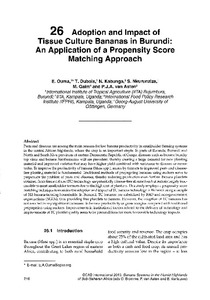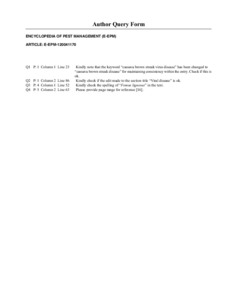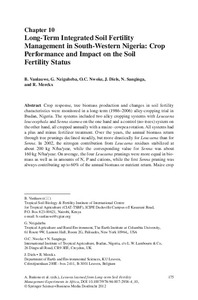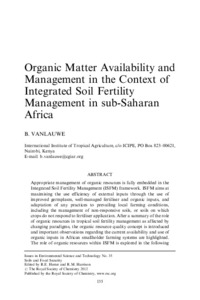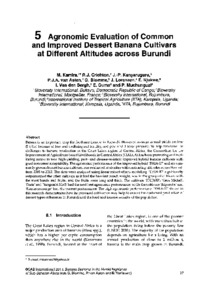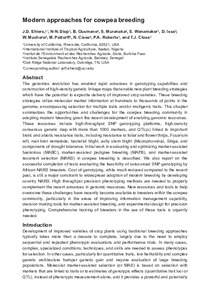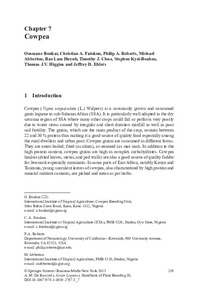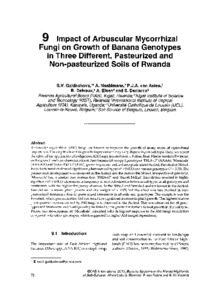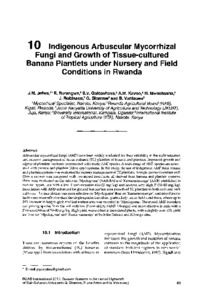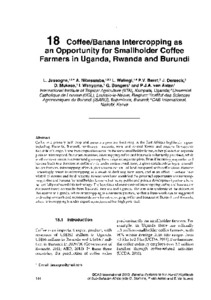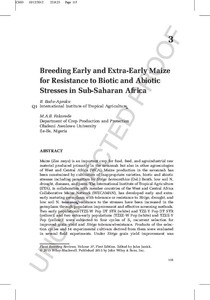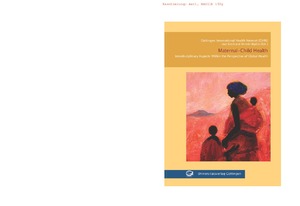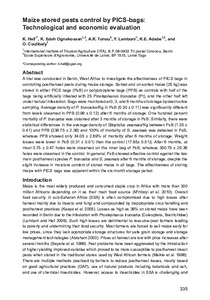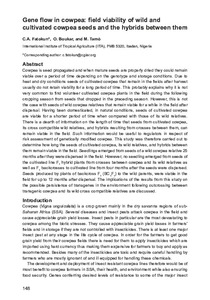Welcome to the International Institute of Tropical Agriculture Research Repository
Books and Book Chapters: Recent submissions
Now showing items 941-960 of 977
-
Adoption and impact of tissue culture bananas in Burundi: an application of a propensity score matching approach
(Centre for Agriculture and Bioscience International, 2013)Pests and diseases are among the main reasons for low banana productivity in smallholder farming systems in the central African highlands, where the crop is an important staple, In parts of Rwanda, Burundi and North and South Kivu provinces of eastern Democratic Republic of Congo, diseases such as banana bunchy top virus and banana Xanthomonas wilt are prevalent, thereby creating a large demand for new planting material and improved varieties that may have higher yield combined with resistance to ... -
Cassava diseases: ecology and control
(Taylor and Francis, 2012)Cassava is an important crop in many parts of the tropics, but it plays a particularly vital role in sustaining food security in sub-Saharan Africa. Diseases are the greatest biotic constraint to cassava production worldwide. Although the diversity of cassava pathogens is greatest in Latin America, the greatest impacts have been reported from Africa. Most significantly, the dual cassava viral pandemics caused by cassava mosaic virus disease (CMD) and cassava brown streak disease (CBSD) have affected ... -
Long-term integrated soil fertility management in South-Western Nigeria: crop performance and impact on the soil fertility status
(Springer, 2012)Crop response, tree biomass production and changes in soil fertility characteristics were monitored in a long-term (1986–2006) alley-cropping trial in Ibadan, Nigeria. The systems included two alley cropping systems with Leucaena leucocephala and Senna siamea on the one hand and a control (no-trees) system on the other hand, all cropped annually with a maize- cowpea rotation. All systems had a plus and minus fertilizer treatment. Over the years, the annual biomass return through tree prunings ... -
Organic matter availability and management in the context of integrated soil fertility management in sub-Saharan Africa
(Royal Society of Chemistry, 2012)Appropriate management of organic resources is fully embedded in the Integrated Soil Fertility Management (ISFM) framework. ISFM aims at maximising the use efficiency of external inputs through the use of improved germplasm, well-managed fertiliser and organic inputs, and adaptation of any practices to prevailing local farming conditions, including the management of non-responsive soils, or soils on which crops do not respond to fertiliser application. After a summary of the role of organic resources ... -
Agronomic evaluation of common and improved dessert banana cultivars at different altitudes across Burundi
(Centre for Agriculture and Biosciences International, 2013)Banana is an important crop for food and income in Burundi. However, average annual yields are low (5 t/ha) because of low and declining soil fertility, and pest and disease pressure. To help overcome the challenges to banana production in the Great Lakes region of Central Africa, the Consortium for the Improvement of Agriculture-based Livelihoods in Central Africa (CIALCA) has been promoting and facilitating access to new high-yielding, pest- and disease-resistant improved hybrid banana cultivars ... -
Modern approaches for cowpea breeding
(International Institute of Tropical Agriculture, 2012)The genomics revolution has enabled rapid advances in genotyping capabilities and construction of high-density genetic linkage maps that enable new plant breeding strategies which have the potential to expedite delivery of improved crop varieties. These breeding strategies utilize molecular marker information at hundreds to thousands of points in the genome, encompassing selection for multiple traits and/or multigenic traits. This chapter summarizes the opportunities and challenges for the cowpea ... -
A comparative and systems approach to banana cropping systems in the Great Lakes region
(CABI, 2013)To explore the diversity and efficiency of smallholder farms, we developed an approach based on a comparative framework and a systems analysis, Five sites in three countries (Rwanda, Burundi and Democratic Republic of Congo) were studied in parallel to take account of variations in agro-ecological and institutional conditions. In a systems-based perspective, we used a combination of quantitative (field measurements, economic valuation) and qualitative methods (semi-directed interviews) to capture ... -
Cowpea
(Elsevier, 2013) -
Impact of Arbuscular mycorrhizal fungi on growth of banana genotypes in three different, pasteurized and non-pasteurized soils of Rwanda
(CABI, 2013)Arbuscular mycorrhizal (AM) fungi are known to improve the growth of many crops of agricultural importance. The amplitude of this growth improvement may vary depending on soil type. Here, we report the effect of the application of indigenous AM fungi, isolated from a Nitisol from Kirehe (eastern Rwanda), on the growth and root characteristics of three banana (Musa spp.) genotypes: 'FHIA-l7' (AAAA), 'Musakala' (AAA-EA) and 'Sukali Ndiizi' (AAB), grown in pasteurized and non-pasteurized Acrisol, ... -
Indigenous Arbuscular mycorrhizal fungi and growth of tissue-cultured banana plantlets under nursery and field conditions in Rwanda
(Centre for Agriculture and Biosciences International, 2013)Arbuscular mycorrhizal fungi (AMF) have been , .. ridel), evaluated for their suitability in the acclimatization and nursery management of tissue-cultured (TC) plantlets of banana and plantain Improved growth and vigour of plantlets has been documented with exotic AMP species. A wide range of AMF species are associated with banana and plantain (Musa spp.) systems. In this studj~ the use of indigenous AMF from banana and plantain systems was evaluated for nursery management of TC plantlets. ASingle ... -
Coffee/Banana intercropping as an opportunity for smallholder coffee farmers in Uganda, Rwanda and Burundi
(Centre for Agriculture and Biosciences International, 2013)Coffee is a primary cash crop and banana a primary food crop in the East African highlands region, including Rwanda, Burundi, north-west Tanzania, west and central Kenya and eastern Democratic Republic of Congo. These two crops often occur on the same smallholder farms, either planted on separate plots or intercropped. In certain countries, intercropping coffee and banana is voluntarily practised, while in others governments recommend growing these crops on separate plots. Even if intercropping ... -
Breeding early and extra-early maize for resistance to biotic and abiotic stresses in sub-Saharan Africa
(John Wiley and Sons, 2013-04)Maize (Zea mays) is an important crop for food, feed, and agroindustrial raw material produced primarily in the savannah but also in other agroecologies of West and Central Africa (WCA). Maize production in the savannah has been constrained by cultivation of inappropriate varieties, biotic and abiotic stresses including parasitism by Striga hermonthica (Del.) Benth. low soil N, drought, diseases, and pests. The International Institute of Tropical Agriculture (IITA), in collaboration with member ... -
Status and prospects of biotechnology applications to conservation, propagation and genetic improvement of yam
(CRC Press, 2013)Yam plays a critical role in providing good quantity and quality yield and source of income to combat the challenge of food insecurity in the tropics. Although significant advances in science and technology have improved efficient management and improvement of their genetic resources, the mission of fully exploiting their potentials is yet to be maximally achieved. Lack of formal seed systems increases germplasm losses and reduces yields. Research is needed in the control of tuber dormancy in yam. ... -
Buruli ulcer: a disease which leads to severe disabilities and mostly affects children living in wet agro-ecosystems of West and Central Africa
(Universitatsverlag Gottingen, 2013) -
Processes and partnerships for effective regional surveillance of banana diseases
(Centre for Agriculture and Biosciences International, 2013-12)Crop diseases do not respect country borders and yet preventive measures to curtail the introduction, establishment and spread of diseases are often coordinated on a country-by-country basis. This is because each country has its own mandate to safeguard food security and trade relations. However, knowledge held by researchers and regulatory officials within each country for any given disease can benefit those in neighbouring countries, and this can be reciprocated for other diseases, depending on ... -
Biological controls for aflatoxin reduction
(International Food Policy Research Institute, 2013)Aflatoxin exposure is frequent and widespread in most African countries where the key staples, maize and groundnut, are particularly vulnerable to aflatoxin contamination. Aflatoxin-producing fungi are ubiquitous in Africa where they occupy soil and colonize diverse organic matter while producing spores that associate with crops leading to aflatoxin formation. Aflatoxins need to be managed throughout this region. A biological control technique that greatly reduces aflatoxin contamination of ... -
Effectiveness of cowpea and wild Vigna germplasm distribution and cost implication on their conservation efforts by IITA
(International Institute of Tropical Agriculture, 2012)IITA’s Genetic Resources Center (GRC) maintains over 15,000 accessions of cowpea (Vigna unguiculata L.) and wild Vigna which is available and distributed worldwide for research in food and agriculture. Since 1985, IITA has distributed germplasms for cowpea genetic improvement research to institutions in sub-Saharan Africa, Asia, South America, and USA. The present study is the first attempt to assess the effectiveness of cowpea and wild Vigna distribution mechanisms and to estimate cost for the ... -
Maize stored pests control by PICS-bags: technological and economic evaluation
(IITA, 2012)A trial was conducted in Benin, West Africa to investigate the effectiveness of PICS bags in controlling postharvest pests during maize storage. Sorted and un-sorted maize (25 kg) was stored in either PICS bags (PsB) or polypropylene bags (PPB) as controls with half of the bags being artificially infested with 25 Prostephanus truncatus (Pt), and the other half left under natural infestation. Bags were monitored at 0, 3, and 6 months of storage by destructive sampling. Average density of P. ... -
Biological inoculants for sustainable intensification of agriculture in sub-Saharan Africa smallholder farming systems
(Springer, 2016-11-23)Land degradation in the smallholder farming systems in sub-Saharan Africa is mainly related to insufficient adoption of sustainable agriculture technologies. This study was aimed at investigating the potential of biological inoculants to improve crop yields and control plant diseases in a profitable manner. Three rhizobia inoculants for soybean or common bean, 2 arbuscular mycorrhizae fungi (AMF) for sweet potato, and 2 Trichoderma products for tomato were applied to determine their effect on ... -
Gene flow in cowpea: field viability of wild and cultivated cowpea seeds and the hybrids between them
(International Institute of Tropical Agriculture, 2012)Cowpea is seed propagated and when mature seeds are properly dried they could remain viable over a period of time depending on the genotype and storage conditions. Due to heat and dry conditions seeds of cultivated cowpea that remain in the fields after harvest usually do not retain viability for a long period of time. This probably explains why it is not very common to find volunteer cultivated cowpea plants in the field during the following cropping season from seeds that dropped in the preceding ...

